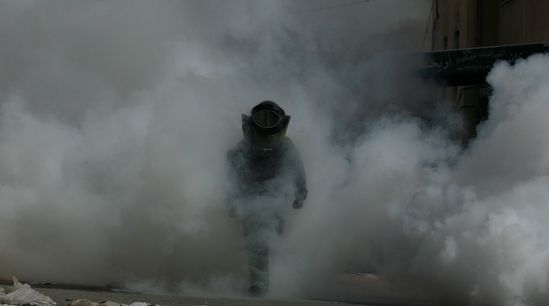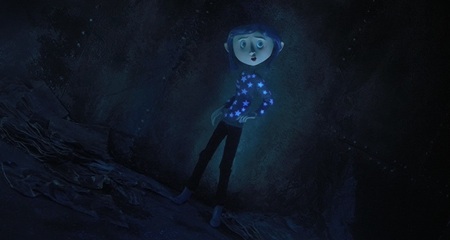 With the expansion of this year's Oscar nominated best pictures from five to ten for the first time since 1943, in what would appear a transparent attempt to insure higher broadcast ratings (by not leaving out another The Dark Knight), one variable remains constant from previous years' selections, whether five or ten: the absence of most of the year's actual 'best' English-language films from the list. Among 2009's ten selections, the only unequivocally deserving for this writer is Kathryn Bigelow's The Hurt Locker (2008; pictured), which extends the director's adrenaline-junkie subject to the Iraqi war context, without succumbing to the standard antiwar moralizing that remains (to its unending detriment) the default mode of the cycle. That Jeremy Renner also received a nomination for his charismatic, picture-carrying lead turn, qualifies as one of the most pleasant surprises, and perceptible selections, among this year's choices. Otherwise, it would seem that Oscar voters, as they almost always do, got it wrong. Below are the remaining nine films (listed alphabetically) and nine selections I would have preferred - or I suppose eight with a ninth, non-qualifying recommendation.
With the expansion of this year's Oscar nominated best pictures from five to ten for the first time since 1943, in what would appear a transparent attempt to insure higher broadcast ratings (by not leaving out another The Dark Knight), one variable remains constant from previous years' selections, whether five or ten: the absence of most of the year's actual 'best' English-language films from the list. Among 2009's ten selections, the only unequivocally deserving for this writer is Kathryn Bigelow's The Hurt Locker (2008; pictured), which extends the director's adrenaline-junkie subject to the Iraqi war context, without succumbing to the standard antiwar moralizing that remains (to its unending detriment) the default mode of the cycle. That Jeremy Renner also received a nomination for his charismatic, picture-carrying lead turn, qualifies as one of the most pleasant surprises, and perceptible selections, among this year's choices. Otherwise, it would seem that Oscar voters, as they almost always do, got it wrong. Below are the remaining nine films (listed alphabetically) and nine selections I would have preferred - or I suppose eight with a ninth, non-qualifying recommendation. James Cameron's AvatarNot As Good As: Henry Selick's Coraline (pictured)
James Cameron's AvatarNot As Good As: Henry Selick's Coraline (pictured)The Connection: 3-D.
Though Bigelow-ex Cameron's Avatar features the year's most luminous color palette and absolutely does mark a major leap forward in 3-D aesthetics - with its subtle, cubic, three-dimensional field - this all-time box office champ also presents an exceedingly muddled, and highly contradictory, shifting critique of western civilization, imperialism, industrialization and militarism. Never mind the (obscenely wealthy) naked emperor behind Avatar, it is for you to save the world - in the way he says, of course, not by emulating what he does. By comparison, Coraline, though it is no less a work of exceptional care and craft, lacks both the technical and political ambitions of Avatar. Yet, Selick clearly exceeds Cameron intellectually in his allegorization of digital, diegetic spaces, where the conceptual world extends only as far as the limits of what the filmmakers have built. Selick helps us to understand the art he makes.
John Lee Hancock's The Blind Side
Not As Good As: Friday Night Lights [TV] (pictured)
The Connection: High school football.
Okay, so I am not suggesting that the Oscar committee faulted in looking past the Peter Berg-created television series . What I am saying, however, is that as a portrait of southern, Christian America - and the world of high school football - there is nothing comparable in American visual culture today (particularly on the level of quality) to Friday Night Lights. Where The Blind Side is a cliché factory in virtually every respect (whether it is the film's screenplay, its performances or even its look), Friday Night Lights not only treats a subject like none other on American television, but it does so through a hand-held shooting style that looks even less familiar. Friday Night Lights belongs to the televisual, long-form twenty-first century idiom that theatrical cinema rarely equals.
 Neill Blomkampf's District 9Not As Good As: J.J. Abrams's Star Trek (pictured)
Neill Blomkampf's District 9Not As Good As: J.J. Abrams's Star Trek (pictured)The Connection: Post-Cloverfield science-fiction.
It's rare, if not unprecedented for a science-fiction film as small as District 9 to secure a 'best picture' nominee. (No film benefited more from the new rules.) And while Blomkampf's work is certainly a passable effort in the Abrams-produced Cloverfield (2008)-mode, Abrams's directorial effort from 2009 ranked as one of the most purely pleasurable pieces of blockbuster filmmaking this year - not that District 9 aspires any less to the tent-pole classification. Here's one instance in which the bigger film truly was better, even if still suffers in comparison to Cloverfield itself (and to that film's theorization of the digital image's palimpsestic nature). Not that ten films a year ago would have led to the then very deserving Cloverfield's inclusion.
 Lone Scherfig's An Education
Lone Scherfig's An EducationNot As Good As: Jane Campion's Bright Star (pictured)
The Connection: The March 2010 Vanity Fair cover.
As very solid as the charming An Education is (and for this writer it is the second best among 2009's choices), Campion's return to her 1990s form nevertheless bests it easily, and every other film chosen this year. While it shares with An Education an outstanding female lead performance from a young actress and a very impressive, un-nominated supporting male turn, Campion's extraordinarily imagistic mise-en-scène and her strong focalization of female desire - she remains ever the 1970s-brand feminist narrationally - unquestionably elevates her latest over the nominated pick.
Quentin Tarantino's Inglourious Basterds
Not As Good As: Judd Apatow's Funny People (pictured)
The Connection: Jews and the cinema.
Among this post's comparisons, the Tarantino vs. Apatow verdict is the one that I most suspect I will reverse in future, when inevitably I overcome Tarantino's problematic revisionism, and can focus instead on his always impressive formalism. For now, I remain firm in insisting that Tarantino's transformation of Holocaust-era Jews into suicide bombers, and his dream scenario in which the cinema takes down the Third Reich, both lack, shall we say, nuance, if not also a minimal moral footing. On the other hand, the unfairly maligned Funny People provides a clear-sighted portrait of its real world-based protagonists, and particularly of the Adam Sandler persona. Sandler (whose input into the film is far more interesting than Apatow's - another reason for possible future revisionism) continues to make some of Hollywood's most interesting choices, without ever receiving the slightest recognition. A Sandler nomination would have been an uncharacteristically gutsy for the Academy.
 Lee Daniels's Precious
Lee Daniels's Precious Not As Good As: Clint Eastwood's Invictus (pictured)
The Connection: Post-Obama racial politics.
Though Oscar-favorite director Eastwood's Invictus does not represent its auteur at the top of his form (like one of the Academy's only truly deserving 'best picture's,' Million Dollar Baby, 2004), it does best the majority of this year's choices inasmuch as it is the latest in the director's seismic readings of the collective American mood: in this instance, America in the immediate, early-2009 afterglow of the Obama election. Lee Daniels's Precious, by comparison, features a racial politics that is astonishingly regressive thanks to its capacity to inspire audience disgust in its African American characters. Really, any other 2009 release would have been preferable to Precious.
Not As Good As: James Gray's Two Lovers (2008; pictured)
The Connection: Middle-class Jewish life.
Joel and Ethan Coen's "Job" without redemption ranks as the runner-up in the least-likable nominee category (to that other 'Job' minus redemption narrative of 2009, Precious). Where it is nowhere near as objectionable in any sense, the Coen's cruelty has rarely been as evident as it is in this second consecutive misfire following co-career-peak, and deserving nominee, No Country for Old Men (2007). Gray's exceedingly precise, stylistically mimetic Two Lovers, which is no less grounded in middle-class Jewish life (though it feels infinitely more authentic to this writer), never seems to have been on Oscar's radar, in spite of being the finest English-language US release of 2009. Oh well, as this post should attest, not making the Academy cut matters very little in qualitative terms.
 Pete Docter and Bob Peterson's UpNot As Good As: Wes Anderson's Fantastic Mr. Fox (pictured)
Pete Docter and Bob Peterson's UpNot As Good As: Wes Anderson's Fantastic Mr. Fox (pictured)The Connection: Animation.
2009's clear animation pick, Wes Anderson's Fantastic Mr. Fox, can at least claim a 'best animated film' nomination, even if it will lose inevitably to the latest Pixar juggernaut. While there is nothing wrong with Up exactly, there is a large degree of critical calculation in its overtly sentimental, aging-protagonist narrative. (In other words, we have genre-revisionism here, though to what end is less clear.) Fantastic Mr. Fox, on the other hand, is certainly the film that its director wanted to make, whatever the box office - or critical - consequences. Moreover, Anderson's latest ranks among the year's most unambiguously personal films, extending the very familiar style, thematic universe and subject (of a stressed or broken family persevering) into unfamiliar, stop-action territory. Wes Anderson, not that Oscar would know it, is one of the leading auteurs of the contemporary American cinema.
 Jason Reitman's Up in the Air
Jason Reitman's Up in the AirNot As Good As: Jim Jarmusch's The Limits of Control (pictured)
The Connection: Business travel.
Lastly, we have a film that was appointed to its nomination and a second that was fated to come and go with at best auteurist critical esteem (which it incomprehensibly lacked, for the most part). Where both films largely inspired ambivalence, the prior track records of the two directors could not be any different: the son of a successful director whose indie film successes have uniformly manifested an at best indifferent visual style, and a pioneer of the same independent cinema who has been responsible for some of the strongest American films of the 1980s and 1990s. So, naturally, Up in the Air and its staggering indifference gets the nod from Oscar over the visually and intellectually ambitious The Limits of Control, the director's best in ten years at least. The Academy Awards would not be what they are without such serious omissions.


2 comments:
It’s great to see good information being shared and also to see fresh, creative ideas that have never been done before.
One year later, I am much less apprehensive about Tarantino's INGLOURIOUS BASTERDS, having since taught the work in a FILM AND AMERICAN HISTORY COURSE. This isn't the first time that I've come to appreciate the director's work belatedly. Accordingly, I would place it alongside THE HURT LOCKER as a deserving nominee.
Post a Comment